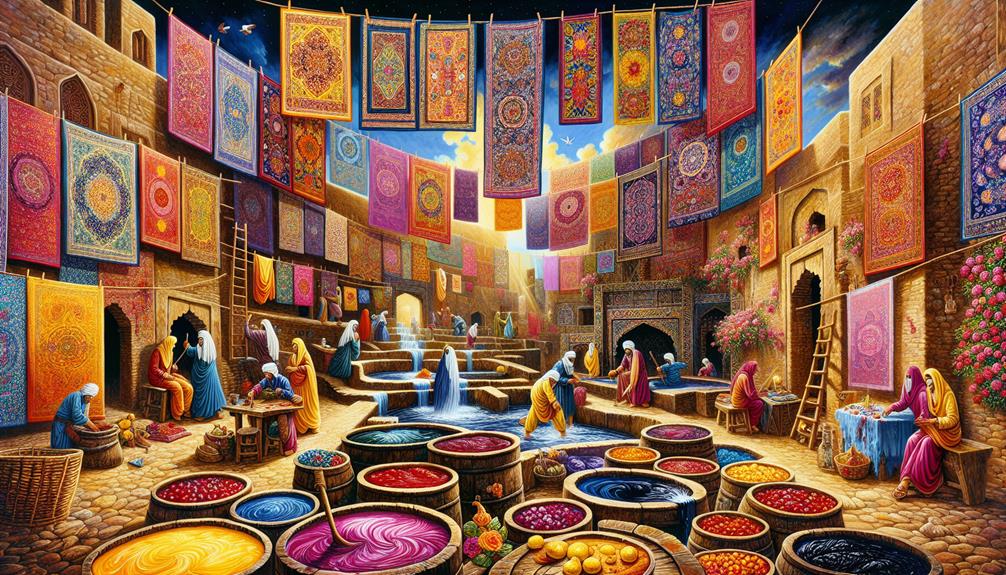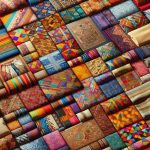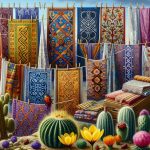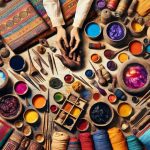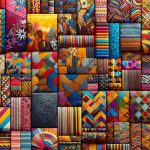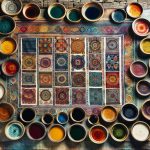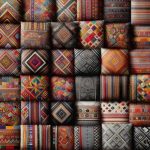Imagine the deep indigo hues of a freshly dyed fabric hanging to dry under a warm sun, the patterns reflecting centuries-old traditions. You might be surprised to learn that fabric dyeing isn't just about aesthetics; it's a journey through time, blending ancient practices with modern techniques. Whether you're intrigued by the natural dyes from plants and insects or the cultural significance of Shibori, there's so much to uncover. What makes this craft even more fascinating is how it balances artistry with sustainability. Curious about how these elements intertwine and shape today's fabric dyeing?
Table of Contents
Key Takeaways
- Ancient techniques: Utilizing natural resources like plants, minerals, and insects, ancient dyeing techniques crafted historically significant and culturally rich textiles.
- Natural vs. synthetic dyes: Natural dyes offer eco-friendly, softer hues, while synthetic dyes provide vibrant colors but have a higher environmental impact.
- Shibori methods: Japanese Shibori techniques like Kanoko, Arashi, and Itajime create intricate patterns and require mastery for stunning indigo shades.
- Modern innovations: Advanced technologies and sustainable practices improve dyeing efficiency, eco-friendliness, and creativity, keeping professionals competitive.
- DIY tips: Understanding color mixing, testing dyes, and mastering techniques like tie dyeing and ombre effects are essential for successful DIY fabric dyeing.
Ancient Dyeing Techniques
Ancient dyeing methods have been practiced for thousands of years, utilizing natural resources like plants, minerals, and insects. If you wish to master these time-honored techniques, you'll need to explore the intricate world of ancient dyeing tools and dyeing traditions. Historically, artisans relied on tools like wooden vats, stone mortars, and pestles to extract vibrant colors. The meticulous process often involved multiple steps, each essential for ensuring the dye adhered properly to the fabric.
Investigating historical dyeing recipes reveals a treasure trove of knowledge. For example, ancient Egyptians used madder root to produce rich reds, while indigo was a staple in many cultures for its deep blues. These recipes didn't just focus on the color but also on the longevity and vibrancy of the dye.
Incorporating these dyeing traditions into your work isn't just about replicating colors; it's about embodying the cultural significance behind each hue. Dyeing rituals were often tied to specific ceremonies, seasons, or social statuses, providing a deeper connection to the fabric. By understanding and applying these ancient techniques, you're not just dyeing fabric; you're continuing a rich, historical tapestry of craftsmanship.
Natural Vs. Synthetic Dyes
When you choose between natural and synthetic dyes, you're deciding on the impact you'll have on both the environment and the quality of your fabric. Natural dyes, derived from plants, minerals, and insects, offer significant sustainability benefits. They generate fewer harmful chemical reactions, making them a greener option. However, they can sometimes lack the vibrancy and consistency of synthetic dyes. Synthetic dyes, created through chemical processes, often provide richer and more uniform colors but can be detrimental to the environment due to the industrial waste and pollutants they produce.
To help you compare, consider the following table:
| Aspect | Natural Dyes | Synthetic Dyes |
|---|---|---|
| Source | Plants, minerals, insects | Chemical compounds |
| Environmental Impact | Low | High |
| Color Vibrancy | Generally softer and varied | Consistently vibrant and rich |
Understanding these differences can guide your choice. If you prioritize sustainability benefits and are willing to embrace unique, softer hues, natural dyes might be your best bet. On the other hand, if you need consistency and intense colors, synthetic dyes could be more suitable, albeit with a higher environmental cost. Consider your priorities and the message you want your fabric to convey.
Traditional Dyeing Methods
When exploring traditional dyeing methods, you'll find that natural dye sources like plants and insects play an essential role.
Techniques such as Shibori, a Japanese method of resist dyeing, create intricate patterns on fabric.
These methods offer a rich cultural history and unique aesthetic results you can't get with modern techniques.
Natural Dye Sources
Natural dye sources, found in plants, minerals, and insects, have been used for centuries to create vibrant, lasting colors in fabric.
To achieve mastery in traditional dyeing methods, you should explore the diverse range of plant extracts available. For instance, indigo, sourced from the leaves of the indigo plant, yields a rich blue hue. Similarly, madder root produces a deep red, while turmeric offers a bright yellow. Each of these plant extracts requires careful preparation and precise application to achieve the desired color intensity and fastness.
In addition to plants, insect secretions have played a significant role in historical dyeing. The cochineal insect, native to Central and South America, produces carminic acid, which yields a brilliant red dye. This dye has been highly prized since ancient times for its vibrant color and durability. Lac insects, found in Southeast Asia, secrete a resin that can be processed into a crimson dye known as lac dye.
Understanding the properties and preparation of these natural dye sources is essential for anyone looking to master traditional fabric dyeing. By harnessing the power of plant extracts and insect secretions, you can create stunning, natural-colored textiles with historical authenticity and modern appeal.
Shibori Techniques
Building on your understanding of traditional dye sources, let's explore the enchanting world of Shibori techniques. Shibori, a Japanese method of resist dyeing, creates intricate patterns by folding, twisting, or bunching cloth and binding it before dyeing. It's an art form that offers endless possibilities for creativity.
In Shibori, indigo dyeing techniques are particularly revered. The deep, rich blue of indigo has been cherished for centuries. By mastering indigo, you'll reveal a palette of stunning shades and patterns. Here's a quick guide to some popular Shibori tie dye variations:
| Technique | Description |
|---|---|
| Kanoko Shibori | Similar to Western tie-dye; fabric is bound tightly with thread. |
| Arashi Shibori | Fabric is wrapped around a pole, then tightly bound and dyed. |
| Itajime Shibori | Fabric is folded and clamped between two pieces of wood. |
Each technique offers a unique visual effect. Kanoko Shibori results in circular patterns, Arashi Shibori produces diagonal stripes reminiscent of a storm, and Itajime Shibori creates geometric designs. Practice these methods and you'll gain a deeper appreciation for the traditional artistry behind Shibori. The key to mastery lies in experimenting and refining your technique. Happy dyeing!
Cultural Significance
Throughout history, fabric dyeing has played an essential role in expressing cultural identity and heritage. You'll find that various cultures around the world have developed unique dyeing practices that imbue fabrics with symbolic meanings.
For instance, in many African communities, the use of indigo dye is deeply rooted in social and spiritual traditions. The symbolic meanings behind each color and pattern can communicate everything from social status to historical narratives.
Color symbolism is equally crucial in Asian fabric traditions. In China, the color red signifies good fortune and joy, often used in celebrations like weddings and New Year festivities. Japan's use of natural dyes in kimono-making reflects a rich history of aesthetics and nature's influence on fabric craftsmanship.
These traditions aren't just about aesthetics; they're an integral part of cultural storytelling.
Modern Innovations
Advancements in fabric dyeing technology have revolutionized the industry, offering more sustainable and vibrant options than ever before. You'll find that today's eco-friendly options utilize natural dyes derived from plants, minerals, and even microorganisms, significantly reducing the environmental impact. These innovations not only minimize harmful chemicals but also conserve water and energy, aligning with the growing demand for sustainability in fashion and textiles.
Technological advancements have also led to the development of digital dyeing techniques. Inkjet printing, for instance, allows for precise application of dyes, reducing waste considerably. This method gives designers the freedom to create intricate patterns and colors with unparalleled accuracy, making it easier to achieve consistent results.
Moreover, biotechnology is paving the way for cutting-edge solutions like synthetic biology, where microorganisms are engineered to produce vibrant, long-lasting dyes. This approach not only opens up a wider palette of colors but also guarantees that the dyeing process is more efficient and less harmful to the environment.
Incorporating these modern innovations, you can master the art of fabric dyeing while championing sustainability and creativity. Embrace these advances to stay ahead in an ever-evolving industry.
DIY Dyeing Tips
Changing your fabrics at home can be both enjoyable and rewarding with these DIY dyeing tips. Start by understanding color mixing. Mastering this skill guarantees you achieve the exact hues you envision. Use primary colors to create a spectrum of shades, and always test on a small fabric piece first.
Next, explore tie dyeing. It's a classic method that allows you to create vibrant, unique patterns. For a professional finish, tightly bind your fabric with rubber bands before applying dye. The tighter the bind, the more defined the patterns will be.
For a more subtle gradient, try the ombre effect. Dip your fabric gradually into the dye, allowing the color to fade naturally from dark to light. Patience is key here—let each section absorb the dye slowly for a seamless shift.
Resist dyeing offers another creative avenue. Techniques like batik, which uses wax to resist dye, can produce intricate designs. Apply the resist material in your desired pattern, then dye the fabric. Once the resist is removed, you'll reveal stunning, contrasting designs.
Frequently Asked Questions
What Are the Environmental Impacts of Fabric Dyeing?
You need to understand that fabric dyeing's environmental impacts include significant water pollution. To mitigate this, adopting sustainable practices is essential. You'll reduce harmful emissions and conserve resources, promoting a healthier ecosystem.
How Can Dyed Fabrics Be Maintained to Prevent Fading?
Imagine your favorite red dress fading to pink. To safeguard color preservation and fabric care, wash it in cold water and dry it indoors. Avoid sun exposure for fading prevention and maintain that vibrant hue.
Are There Any Health Risks Associated With Fabric Dyeing?
Yes, there are health risks associated with fabric dyeing. You should always follow safety measures, like wearing gloves and masks, to prevent exposure to harmful chemicals. Proper ventilation is essential to avoid inhaling toxic fumes.
What Are the Economic Implications of the Fabric Dyeing Industry?
You'll find that the fabric dyeing industry offers significant economic benefits but also faces challenges. Stay updated on market trends and innovations to maximize profitability and navigate the industry's evolving landscape effectively.
How Can One Identify High-Quality Dyed Fabrics?
You can identify high-quality dyed fabrics by checking for color fastness and durability. Guarantee the fabric care instructions promote preservation. Look for consistent coloring, even distribution, and resistance to fading or bleeding during washing.
- Tetron Fabric for Marine Applications: Durability and Use Cases - June 18, 2025
- Tetron Fabric for Outdoor Furniture: Weather Resistance and Care - June 18, 2025
- Tetron Fabric for Wall Coverings: Style and Application Tips - June 18, 2025

